
- Inhibitors
- By product type
- Natural Products
- Inducing Agents
- Peptides
- Antibiotics
- Antibody-drug Conjugates(ADC)
- PROTAC
- Hydrotropic Agents
- Dyes
- By Signaling Pathways
- PI3K/Akt/mTOR
- Epigenetics
- Methylation
- Immunology & Inflammation
- Protein Tyrosine Kinase
- Angiogenesis
- Apoptosis
By research - Antibodies
- Compound Libraries
- Popular Compound Libraries
- Customize Library
- Clinical and FDA-approved Related
- Bioactive Compound Libraries
- Inhibitor Related
- Natural Product Related
- Metabolism Related
- Cell Death Related
- By Signaling Pathway
- By Disease
- Anti-infection and Antiviral Related
- Neuronal and Immunology Related
- Fragment and Covalent Related
- FDA-approved Drug Library
- FDA-approved & Passed Phase I Drug Library
- Preclinical/Clinical Compound Library
- Bioactive Compound Library-I
- Bioactive Compound Library-II
- Kinase Inhibitor Library
- Express-Pick Library
- Natural Product Library
- Human Endogenous Metabolite Compound Library
- Alkaloid Compound LibraryNew
- Angiogenesis Related compound Library
- Anti-Aging Compound Library
- Anti-alzheimer Disease Compound Library
- Antibiotics compound Library
- Anti-cancer Compound Library
- Anti-cancer Compound Library-Ⅱ
- Anti-cancer Metabolism Compound Library
- Anti-Cardiovascular Disease Compound Library
- Anti-diabetic Compound Library
- Anti-infection Compound Library
- Antioxidant Compound Library
- Anti-parasitic Compound Library
- Antiviral Compound Library
- Apoptosis Compound Library
- Autophagy Compound Library
- Calcium Channel Blocker LibraryNew
- Cambridge Cancer Compound Library
- Carbohydrate Metabolism Compound LibraryNew
- Cell Cycle compound library
- CNS-Penetrant Compound Library
- Covalent Inhibitor Library
- Cytokine Inhibitor LibraryNew
- Cytoskeletal Signaling Pathway Compound Library
- DNA Damage/DNA Repair compound Library
- Drug-like Compound Library
- Endoplasmic Reticulum Stress Compound Library
- Epigenetics Compound Library
- Exosome Secretion Related Compound LibraryNew
- FDA-approved Anticancer Drug LibraryNew
- Ferroptosis Compound Library
- Flavonoid Compound Library
- Fragment Library
- Glutamine Metabolism Compound Library
- Glycolysis Compound Library
- GPCR Compound Library
- Gut Microbial Metabolite Library
- HIF-1 Signaling Pathway Compound Library
- Highly Selective Inhibitor Library
- Histone modification compound library
- HTS Library for Drug Discovery
- Human Hormone Related Compound LibraryNew
- Human Transcription Factor Compound LibraryNew
- Immunology/Inflammation Compound Library
- Inhibitor Library
- Ion Channel Ligand Library
- JAK/STAT compound library
- Lipid Metabolism Compound LibraryNew
- Macrocyclic Compound Library
- MAPK Inhibitor Library
- Medicine Food Homology Compound Library
- Metabolism Compound Library
- Methylation Compound Library
- Mouse Metabolite Compound LibraryNew
- Natural Organic Compound Library
- Neuronal Signaling Compound Library
- NF-κB Signaling Compound Library
- Nucleoside Analogue Library
- Obesity Compound Library
- Oxidative Stress Compound LibraryNew
- Plant Extract Library
- Phenotypic Screening Library
- PI3K/Akt Inhibitor Library
- Protease Inhibitor Library
- Protein-protein Interaction Inhibitor Library
- Pyroptosis Compound Library
- Small Molecule Immuno-Oncology Compound Library
- Mitochondria-Targeted Compound LibraryNew
- Stem Cell Differentiation Compound LibraryNew
- Stem Cell Signaling Compound Library
- Natural Phenol Compound LibraryNew
- Natural Terpenoid Compound LibraryNew
- TGF-beta/Smad compound library
- Traditional Chinese Medicine Library
- Tyrosine Kinase Inhibitor Library
- Ubiquitination Compound Library
-
Cherry Picking
You can personalize your library with chemicals from within Selleck's inventory. Build the right library for your research endeavors by choosing from compounds in all of our available libraries.
Please contact us at info@selleckchem.com to customize your library.
You could select:
- Bioreagents
- qPCR
- 2x SYBR Green qPCR Master Mix
- 2x SYBR Green qPCR Master Mix(Low ROX)
- 2x SYBR Green qPCR Master Mix(High ROX)
- Protein Assay
- Protein A/G Magnetic Beads for IP
- Anti-DYKDDDDK Tag magnetic beads
- Anti-DYKDDDDK Tag Affinity Gel
- Anti-Myc magnetic beads
- Anti-HA magnetic beads
- Poly DYKDDDDK Tag Peptide lyophilized powder
- Protease Inhibitor Cocktail
- Protease Inhibitor Cocktail (EDTA-Free, 100X in DMSO)
- Phosphatase Inhibitor Cocktail (2 Tubes, 100X)
- Cell Biology
- Cell Counting Kit-8 (CCK-8)
- Animal Experiment
- Mouse Direct PCR Kit (For Genotyping)
- Featured Products
- MRTX1133
- Nab-Paclitaxel
- KP-457
- IAG933
- RMC-6236 (Daraxonrasib)
- RMC-7977
- Zoldonrasib (RMC-9805)
- GsMTx4
- Navitoclax (ABT-263)
- TSA (Trichostatin A)
- Y-27632 Dihydrochloride
- SB431542
- SB202190
- MK-2206 Dihydrochloride
- LY294002
- Alisertib (MLN8237)
- XAV-939
- CHIR-99021 (Laduviglusib)
- Bafilomycin A1 (Baf-A1)
- Thiazovivin (TZV)
- CP-673451
- Verteporfin
- DAPT
- Galunisertib (LY2157299)
- MG132
- SBE-β-CD
- Tween 80
- Bavdegalutamide (ARV-110)
- Z-VAD-FMK
- Wnt-C59 (C59)
- IWR-1-endo
- (+)-JQ1
- 3-Deazaneplanocin A (DZNep) Hydrochloride
- RepSox (E-616452)
- Erastin
- Q-VD-Oph
- Puromycin Dihydrochloride
- Cycloheximide
- Telaglenastat (CB-839)
- A-83-01
- Ceralasertib (AZD6738)
- Liproxstatin-1
- Emricasan (IDN-6556)
- PMA (Phorbol 12-myristate 13-acetate)
- Dibutyryl cAMP (Bucladesine) sodium
- Nedisertib (M3814)
- PLX5622
- IKE (Imidazole Ketone Erastin)
- STM2457
- Saruparib (AZD5305)
- New Products
- Contact Us
ATPase
Transmembrane Transporters
DPP
Aminopeptidase
Procollagen C Proteinase
P450 (e.g. CYP17)
Phospholipase (e.g. PLA)
Factor Xa
PDE
DHFR
Carbonic Anhydrase
Hydroxylase
Liver X Receptor
FAAH
Acyltransferase
Dehydrogenase
Phosphorylase
PPAR
CYP17
FXR
HMG-CoA Reductase
Transferase
IDO/TDO
Retinoid Receptor
Casein Kinase
NAMPT
phosphatase
Lipase
Lipoxygenase
Thioredoxin
Decarboxylase
Vitamin
Serine/threonin kinase
LDL
Fatty Acid Synthase
FOX
Glycogen synthesis
PKM
Glycolysis
HDL
Carbohydrate Metabolism
ATP-citrate lyase
Acetyl-CoA carboxylase
CYP450
PCSK9
Leukotriene
PDHK
PGC-1α
ROR
FABP
Peroxidases
Aldose Reductase
Xanthine Oxidase
THR
Epoxide Hydrolase
PEP
GTPCH
FAO
PAI-1
LDH
SCD
PREP
CPSase
Mannosidase
Thioredoxin Reductase
SGK
FTase
γGCS
CPT
SREBP
Mitochondrial Metabolism
PARG
Glucosylceramide Synthase
Catalase
3-MST
Serine hydrolase
CAR
glucocerebrosidase
Mitochondrial pyruvate carrier
GOT
SHIP
SOD
LCN
Endogenous Metabolite
ATGL
NMT
Aconitase
AGEs
Amino Acids and Derivatives
Amylase
Drug Metabolite
Glucokinase
Glucosidase
glycosidase
GSNOR
GST
Hexokinase
Isocitrate Dehydrogenase (IDH)
Lipid
Liposome
LPL Receptor
MAGL
NEDD4-1
NPC1L1
PGK1
Reductase
stilbene oxidase
UGT
Isoform-selective Products
- All (55)
- ATPase Inhibitors (48)
- ATPase Activators (6)
- ATPase Antagonist (1)
- New ATPase Products
| Cat.No. | Product Name | Information | Product Use Citations | Product Validations |
|---|---|---|---|---|
| S7046 | Brefeldin A (BFA) | Brefeldin A (BFA) is a lactone antibiotic and ATPase inhibitor for protein transport with IC50 of 0.2 μM in HCT 116 cells, induces cancer cell differentiation and apoptosis. It could also improve the HDR(homology-directed repair) efficiency and be an enhancer of CRISPR-mediated HDR. Brefeldin A is also an inhibitor of autophagy and mitophagy. |
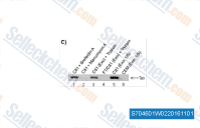
|
|
| S7099 | (-)-Blebbistatin | (-)-Blebbistatin ((S)-(-)-Blebbistatin) is a cell-permeable inhibitor for non muscle myosin II ATPase with IC50 of ~2 μM in cell-free assays, does not inhibit myosin light chain kinase, inhibits contraction of the cleavage furrow without disrupting mitosis or contractile ring assembly. |
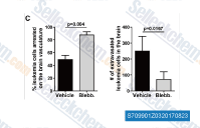
|
|
| S8101 | CB-5083 | CB-5083 is a potent, selective, and orally bioavailable p97 AAA ATPase inhibitor with IC50 of 11 nM. Phase 1. |
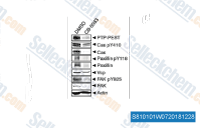
|
|
| S4290 | Digoxin | Digoxin is a classical Na,K-ATPase inhibitor, with selectivity for the α2β3 isoform over the common α1β1 isoform, used in the treatment of atrial fibrillation and heart failure.This product is a hazardous chemical (acute toxicity/flammable/skin corrosive). Please use it while wearing a protective face mask, gloves, and clothing. | ||
| S2000 | Sodium orthovanadate | Sodium orthovanadate is an alkaline phosphatase and (Na,K)-ATPase inhibitor with IC50 of 10 μM. | ||
| S2233 | Esomeprazole sodium | Esomeprazole Sodium((S)-Omeprazole sodium, (-)-Omeprazole sodium) is a sodium salt of esomeprazole that is a potent proton pump inhibitor with an IC50 of 0.076 mg/kg. | ||
| S7266 | Golgicide A | Golgicide A is a potent and rapidly reversible GBF1 inhibitor. |
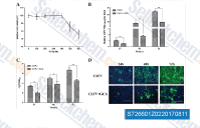
|
|
| S3019 | Ciclopirox ethanolamine | Ciclopirox ethanolamine (Ciclopirox olamine, HOE 296,Ciclopiroxolamine) is a broad-spectrum antifungal agent working as an iron chelator. | ||
| S2528 | Ciclopirox | Ciclopirox (HOE 296b, Penlac) is a broad-spectrum antifungal agent working as an iron chelator. This compound is a broad-spectrum antifungal agent working as an iron chelator. This chemical is a broad-spectrum antifungal agent working as an iron chelator. | ||
| S5623 | Bedaquiline | Bedaquiline (TMC-207, R207910), a diarylquinoline, binds to subunit c of mycobacterial ATP synthase and inhibits its activity. It is highly selective for the mycobacterial ATP synthase enzyme compared to the homologous eukaryotic enzyme (Selectivity Index >20 000). | ||
| S7460 | BTB06584 | BTB06584 is an IF1-dependent, selective inhibitor of the mitochondrial F1 Fo-ATPase. |
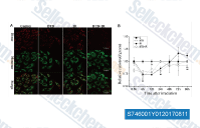
|
|
| S3924 | Ginsenoside Rb1 | Ginsenoside Rb1 (Gypenoside Ⅲ) is a protopanaxadiol that has diverse in vitro and in vivo effects, including neuroprotective, anti-inflammatory, and anti-obesity actions. This compound, a main constituent of the root of Panax ginseng, inhibits Na+, K+-ATPase activity with IC50 of 6.3±1.0 μM. It also inhibits IRAK-1 activation and phosphorylation of NF-κB p65. This chemical reduces the expressions of TLR3, TLR4 and TRAF-6, and down-regulates the levels of TNF-α, IFN-β and iNOS. | ||
| S6815 | CDN1163 | CDN1163 is a small molecular allosteric activator of the sarco/endoplasmic reticulum Ca2+-ATPase (SERCA) that improves Ca2+ homeostasis. | ||
| S5608 | Pantoprazole sodium hydrate | Pantoprazole (BY10232, SKF96022) sodium hydrate (Protonix) is a potent inhibitor of H+/K(+)-ATPase with IC50 of 6.8 μM. | ||
| S9181 | Periplocin | Periplocin (Periplocoside), extracted from the traditional herbal medicine cortex periplocae, has cardiac and anticancer activity. This compound could significantly boost proliferation, migration and stimulate collagen production in fibroblast L929 cells, which is dependent on activation of Src/ERK and PI3K/Akt pathways mediated by Na/K-ATPase, and thus promoting wound healing. | ||
| S4166 | Chlorpropamide | Chlorpropamide inhibits Na(+),K(+)-ATPase and stimulates a high affinity cyclic AMP-phosphodiesterase of isolated liver plasma membrane. Chlorpropamide is a sulfonylurea class drug for type 2 diabetes mellitus. | ||
| S3577 | Rhodamine 123 | Rhodamine 123 (RH-123, R-22420) is a fluorescent cationic dye used to label mitochondria in living cells. This compound inhibits ADP-stimulated respiration of mitochondria with Ki = 12 μM and ATPase activity of inverted inner membrane vesicles with Ki of 126 μM and partially purified F1-ATPase with Ki of 177 μM. | ||
| S5454 | Saikosaponin D | Saikosaponin D, a calcium mobilizing agent (SERCA inhibitor), is a type of Saponin derivative, which is a component extracted from Bupleurum falactum. This compound has anti-cancer activities. | ||
| E1311 | Paxilline | Paxilline, an indole alkaloid mycotoxin derived from Penicillium paxilli, potently inhibits the BK channel by exerting its effects through direct channel inhibition. Additionally, this compound also functions as an inhibitor of sarco/endoplasmic reticulum Ca2+-stimulated ATPase (SERCA), with IC50 values ranging from 5 μM-50 μM, depending on the SERCA isoform. It also possesses significant anticonvulsant and neuroprotective effects. | ||
| E0244 | Acevaltrate | Acevaltrate, an active component derived from the herbal plant Valeriana jatamansi Jones, is strikingly potent to induce GBM cell apoptosis. This compound inhibits the Na+/K+-ATPase activity in the rat kidney and brain hemispheres with IC50 of 22.8 μM and 42.3 μM, respectively. | ||
| S7895 | Thapsigargin | Thapsigargin is a potent, non-competitive inhibitor of the sarco/endoplasmic reticulum Ca2+ ATPase (SERCA) with IC50 of 0.353 nM or 0.448 nM for the carbachol-evoked [Ca2+]i-transients with or without a KCl-prestimulation. Thapsigargin induces cell apoptosis. Thapsigargin is extracted from a plant, Thapsia garganica. | ||
| S7821 | Bufalin | Bufalin (BF) is a potent inhibitor of steroid receptor coactivator SRC-3, SRC-1 and Na+/K+-ATPase. This compound binds to the subunit α1, α2 and α3 of Na+/K+-ATPase with Kd of 42.5 nM, 45 nM and 40 nM, respectively. It is a major immunoreactive component isolated from the Chinese medicine Chan Su with anti-cancer activity. | ||
| E1251 | Oligomycin | Oligomycin is a macrolide antibiotic produced by Streptomyces. It is a mixture of three isomers, namely Oligomycin A, B and C. This compound is an inhibitor of mitochondrial F0 subunit H+-ATP synthase, which can disrupt oxidative phosphorylation and the electron transport chain. It can inhibit TNF-induced apoptosis and can be used as an antifungal antibiotic. | ||
| E4087 | Sodium oleate | Sodium oleate (Oleic acid sodium salt) is an abundant monounsaturated fatty acid sodium. It is a Na+/K+ ATPase activator and inhibits cancer cell growth and survival in low metastatic carcinoma cells, such as gastric carcinoma SGC7901 and breast carcinoma MCF-7 cell lines. | ||
| E0054 | Tegoprazan | Tegoprazan (CJ-12420, IN-A001, K-CAB, LXI-15028, RQ-00000004) is a novel potent and highly selective inhibitor of gastric H+/K+-ATPase with IC50s ranging from 0.29 μM to 0.52 μM for porcine, canine, and human H+/K+-ATPases in vitro, respectively. | ||
| S0161 | ML367 | ML367 is a potent, micromolar inhibitor of ATPase family AAA domain-containing protein 5 (ATAD5) stabilization. This compound blocks DNA repair pathways and general DNA damage responses including RPA32-phosphorylation and CHK1-phosphorylation in response to UV irradiation. | ||
| E0680 | Deslanoside | Deslanoside(Desacetyllanatoside C) is a cardenolide glycoside, has the effects of anti-arrhythmia and cardiotonic, also is used as an EC 3.6.3.9 (Na+/K+-transporting ATPase) inhibitor. | ||
| S0166 | BRITE338733 | BRITE-338733 is a potent RecA (a DNA-dependent ATPase) inhibitor with IC50 of 4.7 µM. | ||
| S6918 | Oleandrin (PBI-05204) | Oleandrin (PBI-05204, Foliandrin, Neriolin, Neriostene, Folinerin, Corrigen, Neriol) is an inhibitor of Na+/K+-ATPase with IC50 of 0.62 μM. This compound induces apoptosis and reduces migration of human glioma cells in vitro. | ||
| E1983New | BAY-850 | BAY-850 is a potent and isoform-selective inhibitor of the ATPase family AAA domain-containing protein 2 (ATAD2) bromodomain, with an IC50 of 166 nM in TR-FRET assays. It induces ATAD2 bromodomain dimerization and effectively blocks its interaction with acetylated histones in vitro. | ||
| S4707 | Oleic Acid | Oleic acid (Oleate, 9-Octadecenoic Acid, Elaidoic acid) is a fatty acid that occurs naturally in various animal and vegetable fats and oils. It is used commercially in the preparation of oleates and lotions, and as a pharmaceutical solvent. Oleic acid is an abundant monounsaturated fatty acid. Oleic acid is a Na+/K+ ATPase activator.Oleic Acid can be used to induce animal models of Renal Failure. | ||
| S0219 | ML241 hydrochloride | ML241 hydrochloride is a potent and selective inhibitor of p97 with IC50 of 0.11 μM and 3.5 μM for p97 ATPase and UbG76V–GFP, respectively. | ||
| S0856 | KM91104 | KM 91104 is a cell-permeable inhibitor of V-ATPase that specifically targets the interaction between V-ATPase subunit a3 and subunit B2. | ||
| S1413 | Bafilomycin A1 (Baf-A1) | Bafilomycin A1 (Baf-A1) is a vacuolar H+-ATPase inhibitor with IC50 of 0.44 nM, and it is found to inhibit autophagy while inducing apoptosis. |
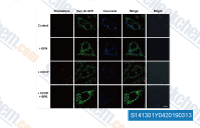
|
|
| S1478 | Oligomycin A (MCH 32) | Oligomycin A (MCH 32), a dominant analog of the isomers, is an inhibitor of mitochondrial F1FO ATP synthase which inhibits oxidative phosphorylation and all the ATP-dependent processes occurring on the coupling membrane of mitochondria. It inhibits ATP synthase by blocking its proton channel (Fo subunit), which is necessary for oxidative phosphorylation of ADP to ATP. It also induces apoptosis in a variety of cell types. |
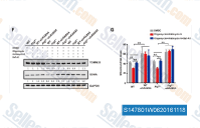
|
|
| S1238 | Tamoxifen | Tamoxifen is an orally active, selective estrogen receptor modulator (SERM) which exhibits both estrogenic agonist and antagonist effects. It blocks estrogen action in breast cells and can activate estrogen activity in other cells, such as bone, liver, and uterine cells. Tamoxifen is a potent Hsp90 activator and enhances the Hsp90 molecular chaperone ATPase activity. |
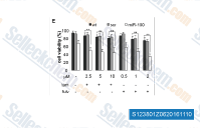
|
|
| S8276 | FCCP | FCCP (Trifluoromethoxy carbonylcyanide phenylhydrazone, Carbonyl cyanide 4-(trifluoromethoxy)phenylhydrazone) is a potent uncoupler of oxidative phosphorylation in mitochondria that disrupts ATP synthesis by transporting protons across cell membranes. |
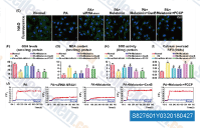
|
|
| S2623 | Omecamtiv mecarbil (CK-1827452) | Omecamtiv mecarbil (CK-1827452) is a specific cardiac myosin activator and a clinical drug for left ventricular systolic heart failure, currently in Phase 2. |
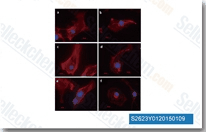
|
|
| S2343 | Phlorizin | Phlorizin (Phloridzin) is a dihydrochalcone found in the bark of pear (Pyrus communis), apple, cherry and other fruit trees. This compound is a non-selective SGLT inhibitor with Ki of 300 nM and 39 nM for hSGLT1 and hSGLT2, respectively. It is also a Na+/K+-ATPase inhibitor. |
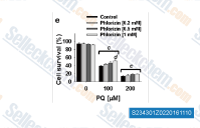
|
|
| S1389 | Omeprazole | Omeprazole is a proton pump inhibitor that blocks H(+)-K(+)-ATPase, used to treat dyspepsia, peptic ulcer disease, gastroesophageal reflux disease, laryngopharyngeal reflux, and Zollinger–Ellison syndrome. | ||
| S2105 | Pantoprazole | Pantoprazole (SKF96022, BY-1023) is a proton pump inhibitor drug that inhibits gastric acid secretion. It works on gastric parietal cells to irreversibly inhibit (H+/K+)-ATPase function and suppress the production of gastric acid. | ||
| S1354 | Lansoprazole | Lansoprazole (A-65006, AG-1749) is a proton-pump inhibitor (PPI) that binds covalently to parietal cell H(+),K(+)-ATPase. This compound prevents the stomach from producing gastric acid. | ||
| S8828 | Gboxin | Gboxin is an inhibitor of oxidative phosphorylation in cancer cells. This compound inhibits the activity of F0F1 ATP synthase. It specifically inhibits the growth of primary mouse and human glioblastoma cells but not that of mouse embryonic fibroblasts or neonatal astrocytes. | ||
| S4099 | Dexlansoprazole | Dexlansoprazole (T 168390, TAK 390,(R)-Lansoprazole), the dextrorotatory enantiomer of lansoprazole, is a proton pump inhibitor (PPI) formulated to have dual delayed-release properties. This compound selectively suppresses gastric acid secretion by direct inhibition of the H(+),K(+)-ATPase proton pump in the gastric parietal cell. | ||
| S3628 | BHQ | BHQ (2,5-di-t-butyl-1,4-benzohydroquinone) is a potent and selective inhibitor of the sarco-endoplasmic reticulum Ca2+-ATPase (SERCA). | ||
| S4538 | Pantoprazole sodium | Pantoprazole (SKF96022, BY-1023) is a proton pump inhibitor drug that inhibits gastric acid secretion. It works on gastric parietal cells to irreversibly inhibit (H+/K+)-ATPase function and suppress the production of gastric acid. | ||
| S5502 | Ilaprazole sodium | Ilaprazole (IY-81149) sodium is the sodium salt form of ilaprazole, which is a proton pump inhibitor. Ilaprazole sodium irreversibly inhibits H(+)/K(+)-ATPase in a dose-dependent manner with IC50 of 6 μM in rabbit parietal cell preparation. | ||
| S3666 | Ilaprazole | Ilaprazole (IY-81149) is a new proton pump inhibitor (PPI) used in the treatment of dyspepsia, peptic ulcer disease (PUD), gastroesophageal reflux disease (GORD/GERD) and duodenal ulcer. It inhibits H+/K+-ATPase with an IC50 of 6.0 μM. | ||
| S4212 | Tenatoprazole | Tenatoprazole (TU-199,STU-Na) is a prodrug of the proton pump inhibitor (PPI) class, which inhibits proton transport with IC50 of 3.2 μM. This compound labels only the gastric H(+),K(+)-ATPase alpha-subunit, approximately 2.6 nM/mg of this chemical is bound to the H(+),K(+)-ATPase. | ||
| E1166 | Tetrathiomolybdate (TM) | Tetrathiomolybdate (TM) is used in the clinic for the treatment of Wilson’s disease by inducing dimerization of the metal-binding domain of the cellular copper efflux protein ATP7B (WLN4) through a unique sulfur-bridged Mo2S6O2 cluster. | ||
| S5058 | Revaprazan Hydrochloride | Revaprazan Hydrochloride (YH1885) is a new reversible proton pump inhibitor with long-lasting acid-suppressive effects. This compound reversibly inhibits H(+)/K(+)-ATPase via binding to the K+-binding site of the pump. | ||
| S1743 | Esomeprazole magnesium | Esomeprazole Magnesium(NEXIUM) is a proton pump inhibitor to reduce gastric acid secretion through inhibition of H(+)/K(+)-ATPase in gastric parietal cells. | ||
| S2222 | PF-3716556 | PF 3716556 is a potent and selective P-CAB (potassium-competitive acid blocker), with pIC50 of 6.026 and 7.095 for the inhibition of porcine H+,K+-ATPase activity in ion-leaky and ion-tight assay, respectively, inhibits gastric acid secretion, displays no activity at Na+,K+-ATPase, used for the treatment of gastroesophageal reflux disease. | ||
| S3143 | Pyruvic acid |
Pyruvic acid (Acetylformic acid) is an important organic chemical intermediate that plays a role in cardiomyocyte pathophysiology and therapy. This compound markedly increases the level of lactate dehydrogenase (LDH) and creatine kinase (CK) and reduces the level of Ca2+Mg2+-ATPase and Na+K+-ATPase. |
||
| E0483 | Calmidazolium chloride | Calmidazolium chloride (R 24571) is a calmodulin (CaM) antagonist, antagonizing CaM-stimulated fraction of rat brain phosphodiesterase and CaM-induced activation of erythrocyte Ca2+-transporting ATPase with IC50s of 0.15 and 0.35 μM, respectively, also shows a CaM-binding Kd value of 3 nM. | ||
| S7046 | Brefeldin A (BFA) | Brefeldin A (BFA) is a lactone antibiotic and ATPase inhibitor for protein transport with IC50 of 0.2 μM in HCT 116 cells, induces cancer cell differentiation and apoptosis. It could also improve the HDR(homology-directed repair) efficiency and be an enhancer of CRISPR-mediated HDR. Brefeldin A is also an inhibitor of autophagy and mitophagy. |

|
|
| S7099 | (-)-Blebbistatin | (-)-Blebbistatin ((S)-(-)-Blebbistatin) is a cell-permeable inhibitor for non muscle myosin II ATPase with IC50 of ~2 μM in cell-free assays, does not inhibit myosin light chain kinase, inhibits contraction of the cleavage furrow without disrupting mitosis or contractile ring assembly. |

|
|
| S8101 | CB-5083 | CB-5083 is a potent, selective, and orally bioavailable p97 AAA ATPase inhibitor with IC50 of 11 nM. Phase 1. |

|
|
| S4290 | Digoxin | Digoxin is a classical Na,K-ATPase inhibitor, with selectivity for the α2β3 isoform over the common α1β1 isoform, used in the treatment of atrial fibrillation and heart failure.This product is a hazardous chemical (acute toxicity/flammable/skin corrosive). Please use it while wearing a protective face mask, gloves, and clothing. | ||
| S2000 | Sodium orthovanadate | Sodium orthovanadate is an alkaline phosphatase and (Na,K)-ATPase inhibitor with IC50 of 10 μM. | ||
| S2233 | Esomeprazole sodium | Esomeprazole Sodium((S)-Omeprazole sodium, (-)-Omeprazole sodium) is a sodium salt of esomeprazole that is a potent proton pump inhibitor with an IC50 of 0.076 mg/kg. | ||
| S7266 | Golgicide A | Golgicide A is a potent and rapidly reversible GBF1 inhibitor. |

|
|
| S3019 | Ciclopirox ethanolamine | Ciclopirox ethanolamine (Ciclopirox olamine, HOE 296,Ciclopiroxolamine) is a broad-spectrum antifungal agent working as an iron chelator. | ||
| S2528 | Ciclopirox | Ciclopirox (HOE 296b, Penlac) is a broad-spectrum antifungal agent working as an iron chelator. This compound is a broad-spectrum antifungal agent working as an iron chelator. This chemical is a broad-spectrum antifungal agent working as an iron chelator. | ||
| S5623 | Bedaquiline | Bedaquiline (TMC-207, R207910), a diarylquinoline, binds to subunit c of mycobacterial ATP synthase and inhibits its activity. It is highly selective for the mycobacterial ATP synthase enzyme compared to the homologous eukaryotic enzyme (Selectivity Index >20 000). | ||
| S7460 | BTB06584 | BTB06584 is an IF1-dependent, selective inhibitor of the mitochondrial F1 Fo-ATPase. |

|
|
| S3924 | Ginsenoside Rb1 | Ginsenoside Rb1 (Gypenoside Ⅲ) is a protopanaxadiol that has diverse in vitro and in vivo effects, including neuroprotective, anti-inflammatory, and anti-obesity actions. This compound, a main constituent of the root of Panax ginseng, inhibits Na+, K+-ATPase activity with IC50 of 6.3±1.0 μM. It also inhibits IRAK-1 activation and phosphorylation of NF-κB p65. This chemical reduces the expressions of TLR3, TLR4 and TRAF-6, and down-regulates the levels of TNF-α, IFN-β and iNOS. | ||
| S5608 | Pantoprazole sodium hydrate | Pantoprazole (BY10232, SKF96022) sodium hydrate (Protonix) is a potent inhibitor of H+/K(+)-ATPase with IC50 of 6.8 μM. | ||
| S4166 | Chlorpropamide | Chlorpropamide inhibits Na(+),K(+)-ATPase and stimulates a high affinity cyclic AMP-phosphodiesterase of isolated liver plasma membrane. Chlorpropamide is a sulfonylurea class drug for type 2 diabetes mellitus. | ||
| S3577 | Rhodamine 123 | Rhodamine 123 (RH-123, R-22420) is a fluorescent cationic dye used to label mitochondria in living cells. This compound inhibits ADP-stimulated respiration of mitochondria with Ki = 12 μM and ATPase activity of inverted inner membrane vesicles with Ki of 126 μM and partially purified F1-ATPase with Ki of 177 μM. | ||
| S5454 | Saikosaponin D | Saikosaponin D, a calcium mobilizing agent (SERCA inhibitor), is a type of Saponin derivative, which is a component extracted from Bupleurum falactum. This compound has anti-cancer activities. | ||
| E1311 | Paxilline | Paxilline, an indole alkaloid mycotoxin derived from Penicillium paxilli, potently inhibits the BK channel by exerting its effects through direct channel inhibition. Additionally, this compound also functions as an inhibitor of sarco/endoplasmic reticulum Ca2+-stimulated ATPase (SERCA), with IC50 values ranging from 5 μM-50 μM, depending on the SERCA isoform. It also possesses significant anticonvulsant and neuroprotective effects. | ||
| E0244 | Acevaltrate | Acevaltrate, an active component derived from the herbal plant Valeriana jatamansi Jones, is strikingly potent to induce GBM cell apoptosis. This compound inhibits the Na+/K+-ATPase activity in the rat kidney and brain hemispheres with IC50 of 22.8 μM and 42.3 μM, respectively. | ||
| S7895 | Thapsigargin | Thapsigargin is a potent, non-competitive inhibitor of the sarco/endoplasmic reticulum Ca2+ ATPase (SERCA) with IC50 of 0.353 nM or 0.448 nM for the carbachol-evoked [Ca2+]i-transients with or without a KCl-prestimulation. Thapsigargin induces cell apoptosis. Thapsigargin is extracted from a plant, Thapsia garganica. | ||
| S7821 | Bufalin | Bufalin (BF) is a potent inhibitor of steroid receptor coactivator SRC-3, SRC-1 and Na+/K+-ATPase. This compound binds to the subunit α1, α2 and α3 of Na+/K+-ATPase with Kd of 42.5 nM, 45 nM and 40 nM, respectively. It is a major immunoreactive component isolated from the Chinese medicine Chan Su with anti-cancer activity. | ||
| E1251 | Oligomycin | Oligomycin is a macrolide antibiotic produced by Streptomyces. It is a mixture of three isomers, namely Oligomycin A, B and C. This compound is an inhibitor of mitochondrial F0 subunit H+-ATP synthase, which can disrupt oxidative phosphorylation and the electron transport chain. It can inhibit TNF-induced apoptosis and can be used as an antifungal antibiotic. | ||
| E0054 | Tegoprazan | Tegoprazan (CJ-12420, IN-A001, K-CAB, LXI-15028, RQ-00000004) is a novel potent and highly selective inhibitor of gastric H+/K+-ATPase with IC50s ranging from 0.29 μM to 0.52 μM for porcine, canine, and human H+/K+-ATPases in vitro, respectively. | ||
| S0161 | ML367 | ML367 is a potent, micromolar inhibitor of ATPase family AAA domain-containing protein 5 (ATAD5) stabilization. This compound blocks DNA repair pathways and general DNA damage responses including RPA32-phosphorylation and CHK1-phosphorylation in response to UV irradiation. | ||
| E0680 | Deslanoside | Deslanoside(Desacetyllanatoside C) is a cardenolide glycoside, has the effects of anti-arrhythmia and cardiotonic, also is used as an EC 3.6.3.9 (Na+/K+-transporting ATPase) inhibitor. | ||
| S0166 | BRITE338733 | BRITE-338733 is a potent RecA (a DNA-dependent ATPase) inhibitor with IC50 of 4.7 µM. | ||
| S6918 | Oleandrin (PBI-05204) | Oleandrin (PBI-05204, Foliandrin, Neriolin, Neriostene, Folinerin, Corrigen, Neriol) is an inhibitor of Na+/K+-ATPase with IC50 of 0.62 μM. This compound induces apoptosis and reduces migration of human glioma cells in vitro. | ||
| E1983New | BAY-850 | BAY-850 is a potent and isoform-selective inhibitor of the ATPase family AAA domain-containing protein 2 (ATAD2) bromodomain, with an IC50 of 166 nM in TR-FRET assays. It induces ATAD2 bromodomain dimerization and effectively blocks its interaction with acetylated histones in vitro. | ||
| S0219 | ML241 hydrochloride | ML241 hydrochloride is a potent and selective inhibitor of p97 with IC50 of 0.11 μM and 3.5 μM for p97 ATPase and UbG76V–GFP, respectively. | ||
| S0856 | KM91104 | KM 91104 is a cell-permeable inhibitor of V-ATPase that specifically targets the interaction between V-ATPase subunit a3 and subunit B2. | ||
| S1413 | Bafilomycin A1 (Baf-A1) | Bafilomycin A1 (Baf-A1) is a vacuolar H+-ATPase inhibitor with IC50 of 0.44 nM, and it is found to inhibit autophagy while inducing apoptosis. |

|
|
| S1478 | Oligomycin A (MCH 32) | Oligomycin A (MCH 32), a dominant analog of the isomers, is an inhibitor of mitochondrial F1FO ATP synthase which inhibits oxidative phosphorylation and all the ATP-dependent processes occurring on the coupling membrane of mitochondria. It inhibits ATP synthase by blocking its proton channel (Fo subunit), which is necessary for oxidative phosphorylation of ADP to ATP. It also induces apoptosis in a variety of cell types. |

|
|
| S8276 | FCCP | FCCP (Trifluoromethoxy carbonylcyanide phenylhydrazone, Carbonyl cyanide 4-(trifluoromethoxy)phenylhydrazone) is a potent uncoupler of oxidative phosphorylation in mitochondria that disrupts ATP synthesis by transporting protons across cell membranes. |

|
|
| S2343 | Phlorizin | Phlorizin (Phloridzin) is a dihydrochalcone found in the bark of pear (Pyrus communis), apple, cherry and other fruit trees. This compound is a non-selective SGLT inhibitor with Ki of 300 nM and 39 nM for hSGLT1 and hSGLT2, respectively. It is also a Na+/K+-ATPase inhibitor. |

|
|
| S1389 | Omeprazole | Omeprazole is a proton pump inhibitor that blocks H(+)-K(+)-ATPase, used to treat dyspepsia, peptic ulcer disease, gastroesophageal reflux disease, laryngopharyngeal reflux, and Zollinger–Ellison syndrome. | ||
| S2105 | Pantoprazole | Pantoprazole (SKF96022, BY-1023) is a proton pump inhibitor drug that inhibits gastric acid secretion. It works on gastric parietal cells to irreversibly inhibit (H+/K+)-ATPase function and suppress the production of gastric acid. | ||
| S1354 | Lansoprazole | Lansoprazole (A-65006, AG-1749) is a proton-pump inhibitor (PPI) that binds covalently to parietal cell H(+),K(+)-ATPase. This compound prevents the stomach from producing gastric acid. | ||
| S8828 | Gboxin | Gboxin is an inhibitor of oxidative phosphorylation in cancer cells. This compound inhibits the activity of F0F1 ATP synthase. It specifically inhibits the growth of primary mouse and human glioblastoma cells but not that of mouse embryonic fibroblasts or neonatal astrocytes. | ||
| S4099 | Dexlansoprazole | Dexlansoprazole (T 168390, TAK 390,(R)-Lansoprazole), the dextrorotatory enantiomer of lansoprazole, is a proton pump inhibitor (PPI) formulated to have dual delayed-release properties. This compound selectively suppresses gastric acid secretion by direct inhibition of the H(+),K(+)-ATPase proton pump in the gastric parietal cell. | ||
| S3628 | BHQ | BHQ (2,5-di-t-butyl-1,4-benzohydroquinone) is a potent and selective inhibitor of the sarco-endoplasmic reticulum Ca2+-ATPase (SERCA). | ||
| S4538 | Pantoprazole sodium | Pantoprazole (SKF96022, BY-1023) is a proton pump inhibitor drug that inhibits gastric acid secretion. It works on gastric parietal cells to irreversibly inhibit (H+/K+)-ATPase function and suppress the production of gastric acid. | ||
| S5502 | Ilaprazole sodium | Ilaprazole (IY-81149) sodium is the sodium salt form of ilaprazole, which is a proton pump inhibitor. Ilaprazole sodium irreversibly inhibits H(+)/K(+)-ATPase in a dose-dependent manner with IC50 of 6 μM in rabbit parietal cell preparation. | ||
| S3666 | Ilaprazole | Ilaprazole (IY-81149) is a new proton pump inhibitor (PPI) used in the treatment of dyspepsia, peptic ulcer disease (PUD), gastroesophageal reflux disease (GORD/GERD) and duodenal ulcer. It inhibits H+/K+-ATPase with an IC50 of 6.0 μM. | ||
| S4212 | Tenatoprazole | Tenatoprazole (TU-199,STU-Na) is a prodrug of the proton pump inhibitor (PPI) class, which inhibits proton transport with IC50 of 3.2 μM. This compound labels only the gastric H(+),K(+)-ATPase alpha-subunit, approximately 2.6 nM/mg of this chemical is bound to the H(+),K(+)-ATPase. | ||
| E1166 | Tetrathiomolybdate (TM) | Tetrathiomolybdate (TM) is used in the clinic for the treatment of Wilson’s disease by inducing dimerization of the metal-binding domain of the cellular copper efflux protein ATP7B (WLN4) through a unique sulfur-bridged Mo2S6O2 cluster. | ||
| S5058 | Revaprazan Hydrochloride | Revaprazan Hydrochloride (YH1885) is a new reversible proton pump inhibitor with long-lasting acid-suppressive effects. This compound reversibly inhibits H(+)/K(+)-ATPase via binding to the K+-binding site of the pump. | ||
| S1743 | Esomeprazole magnesium | Esomeprazole Magnesium(NEXIUM) is a proton pump inhibitor to reduce gastric acid secretion through inhibition of H(+)/K(+)-ATPase in gastric parietal cells. | ||
| S2222 | PF-3716556 | PF 3716556 is a potent and selective P-CAB (potassium-competitive acid blocker), with pIC50 of 6.026 and 7.095 for the inhibition of porcine H+,K+-ATPase activity in ion-leaky and ion-tight assay, respectively, inhibits gastric acid secretion, displays no activity at Na+,K+-ATPase, used for the treatment of gastroesophageal reflux disease. | ||
| S3143 | Pyruvic acid | Pyruvic acid (Acetylformic acid) is an important organic chemical intermediate that plays a role in cardiomyocyte pathophysiology and therapy. This compound markedly increases the level of lactate dehydrogenase (LDH) and creatine kinase (CK) and reduces the level of Ca2+Mg2+-ATPase and Na+K+-ATPase. |
||
| S6815 | CDN1163 | CDN1163 is a small molecular allosteric activator of the sarco/endoplasmic reticulum Ca2+-ATPase (SERCA) that improves Ca2+ homeostasis. | ||
| S9181 | Periplocin | Periplocin (Periplocoside), extracted from the traditional herbal medicine cortex periplocae, has cardiac and anticancer activity. This compound could significantly boost proliferation, migration and stimulate collagen production in fibroblast L929 cells, which is dependent on activation of Src/ERK and PI3K/Akt pathways mediated by Na/K-ATPase, and thus promoting wound healing. | ||
| E4087 | Sodium oleate | Sodium oleate (Oleic acid sodium salt) is an abundant monounsaturated fatty acid sodium. It is a Na+/K+ ATPase activator and inhibits cancer cell growth and survival in low metastatic carcinoma cells, such as gastric carcinoma SGC7901 and breast carcinoma MCF-7 cell lines. | ||
| S4707 | Oleic Acid | Oleic acid (Oleate, 9-Octadecenoic Acid, Elaidoic acid) is a fatty acid that occurs naturally in various animal and vegetable fats and oils. It is used commercially in the preparation of oleates and lotions, and as a pharmaceutical solvent. Oleic acid is an abundant monounsaturated fatty acid. Oleic acid is a Na+/K+ ATPase activator.Oleic Acid can be used to induce animal models of Renal Failure. | ||
| S1238 | Tamoxifen | Tamoxifen is an orally active, selective estrogen receptor modulator (SERM) which exhibits both estrogenic agonist and antagonist effects. It blocks estrogen action in breast cells and can activate estrogen activity in other cells, such as bone, liver, and uterine cells. Tamoxifen is a potent Hsp90 activator and enhances the Hsp90 molecular chaperone ATPase activity. |

|
|
| S2623 | Omecamtiv mecarbil (CK-1827452) | Omecamtiv mecarbil (CK-1827452) is a specific cardiac myosin activator and a clinical drug for left ventricular systolic heart failure, currently in Phase 2. |

|
|
| E0483 | Calmidazolium chloride | Calmidazolium chloride (R 24571) is a calmodulin (CaM) antagonist, antagonizing CaM-stimulated fraction of rat brain phosphodiesterase and CaM-induced activation of erythrocyte Ca2+-transporting ATPase with IC50s of 0.15 and 0.35 μM, respectively, also shows a CaM-binding Kd value of 3 nM. | ||
| E1983New | BAY-850 | BAY-850 is a potent and isoform-selective inhibitor of the ATPase family AAA domain-containing protein 2 (ATAD2) bromodomain, with an IC50 of 166 nM in TR-FRET assays. It induces ATAD2 bromodomain dimerization and effectively blocks its interaction with acetylated histones in vitro. |






































